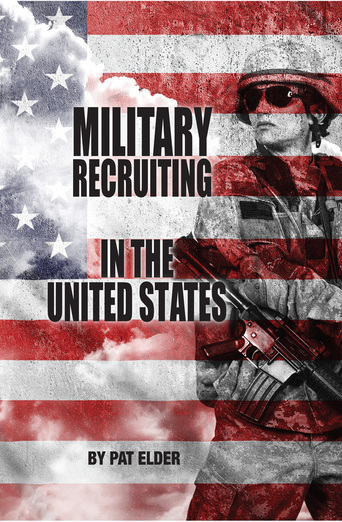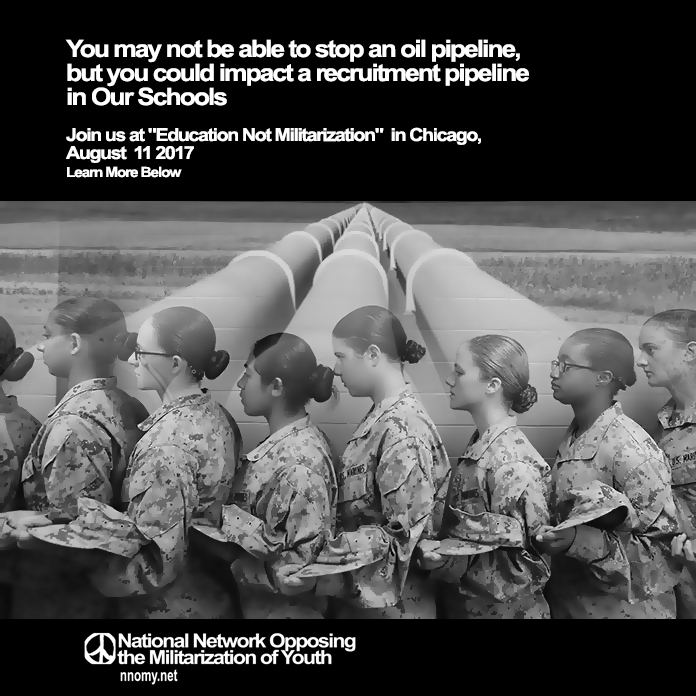
Military Recruiting in the United States and Planning its Decline and Fall
Chapters
1. Military Enlistment Ruins Lives
2. The Military Enlistment Document Is Fraudulent
3. Recruiting Is Psy Ops at Home
4. Should Recruiters “Own” Our Schools?
5. Love Our enemies? Or Kill Them?
6. Hollywood Pledges Allegiance to the Dollar
7. Madison Avenue Joins the Army
8. Video Games Recruit & Train Killers
9. Schools Teach Reading, Writing, & Marksmanship
10. The Pentagon Is Tracking Our Kids
11. “Career Program” Is Enlistment Tool in Camo
12. JROTC Militarizes American Youth
13. U.S. Flouts U.N. Protocol on Child Soldiers
Military Recruiting in the United States is available at Amazon.
Here’s the summary from Amazon:
Military Recruiting in the United States provides a fearless and penetrating
description of the deceptive practices of the U.S. military as it recruits
American youth into the armed forces. Long-time antiwar activist Pat Elder
exposes the underworld of American military recruiting in this explosive and
consequential book. The book describes how recruiters manage to convince
youth to enlist. It details a sophisticated psy-ops campaign directed at
children. Elder describes how the military encourages first-person shooter
games and places firearms into the hands of thousands using the schools, its
JROTC programs, and the Civilian Marksmanship Program to inculcate youth
with a reverence for guns. Previously unpublished investigative work reveals
how indoor shooting ranges in schools are threatening the health of children
and school staff through exposure to lead particulate matter. The book
provides a kind of “what’s coming next manual” for European peacemakers as
they also confront a rising tide of militarism. The book examines the
disturbing, nurturing role of the Catholic Church in recruiting youth. It
surveys the wholesale military censorship of Hollywood films, pervasive
military testing in the high schools, and an explosion of military programs
directed toward youth. For more information, visit: www.counter-recruit.org
<http://www.counter-recruit.org>
David Swanson, of World Without War, has written a review.
Military Recruiting in the United States, and Planning its Decline and Fall
<http://worldbeyondwar.org/military-recruiting-united-states-planning-decline-fall/>
http://worldbeyondwar.org/military-recruiting-united-states-planning-decline-fall/
By David Swanson
*This text is the foreword to a new book by Pat Elder called Military
Recruiting in the United States <http://www.counter-recruit.org>.*
Most people in the United States are far from aware of the full extent of
military marketing, advertising, and recruitment efforts. We run into
movies and comic books and video games and toys and school worksheets and
science fairs and television shows and websites all the time that have been
funded by and created in collaboration with the U.S. military. But we don’t
know it. Or we know it, but we have so internalized the idea that the most
expensive and extensive military the earth has ever known is simply normal,
that we don’t think of its role in our educational and entertainment
systems as in any way questionable. We don’t even think of the military’s
marketing as being aimed at recruitment, much less ask each other whether
that’s a good thing or being done in a proper way, or whether we ourselves
should be forking over some $600 million a year just for the military’s
advertising budget.
Even more people are unaware of the work of counter-recruiters, of
individuals and organizations that work to increase awareness of military
recruitment and to counter it with inconvenient information — that is,
information that may be inconvenient to recruiters but highly useful to
potential recruits. Counter-recruiters bring veterans into schools to talk
about their regrets. Counter-recruiters warn young people of the dangers of
false promises and of contracts that will be binding only on them, not on
the military. Counter recruiters lobby for policy changes that prevent the
military from obtaining information on students without parental consent.
Sometimes — very rarely – counter-recruiters write outstanding books that
inform us of the current state of affairs and guide us toward paths for
engagement with their work. Pat Elder is a counter-recruiter turned author,
and we are all in his debt. This book makes clear the need for
counter-recruitment, and it provides the tools to expand it.
Why is counter-recruitment appropriate even when there is no draft, the
military is all volunteer, and many people reading this book have never
been pressured to enlist at all? Well, 99% of us in the United States are
asked only to pay taxes for wars, vote for war architects for public
office, tell pollsters we support wars, and tolerate war promotion
throughout our culture. Nothing more is asked of us. But what about that
other one percent? Our tax dollars don’t fund a dime’s worth of pro-peace
propaganda for them. Despite warnings of health threats from the American
Medical Association, military recruiters do not, like cigarette or alcohol
marketers, have to provide the slightest shred of warning regarding the
risks involved. They also are permitted to market to younger people than
are the marketers of cigarettes and alcohol. As Elder points out, in most
U.S. states you must be 21 to drink alcohol and 25 to rent a car, but at 18
you can kill or die in war.
Explaining the heavy, one-sided push experienced by targeted young men and
women, disproportionately in low-income communities, to those who haven’t
experienced it, is like trying to explain predatory mortgage loans that
push the borrower to default in order to collect more fees to someone who’s
only ever encountered banks that hoped their loans would be paid back. If
you doubt the reality of aggressive recruitment, that’s not your fault. But
you won’t doubt it after you read this book.
Counter-recruiters don’t make any promises to anyone, though they may try
to help young people find peaceful careers. They don’t ask anyone to sign a
contract to remain peaceful for six or eight or an infinite number of
years. They don’t secretly receive detailed data on students without their
knowledge in order to better target them for counter recruitment. If we are
to truly think of those who enlist in the U.S. military as volunteers, we
are required to make sure they have accurate information. Volunteering on
the basis of insufficient or misleading knowledge is not volunteering at
all. Counter-recruitment, then, is not something to tolerate, but something
to insist upon.
One of the first things a counter-recruiter, and this book, will make
clear, is that even a well-informed volunteer in the U.S. military, unlike
any other volunteer in any other enterprise, is not permitted to cease
volunteering. Even when a contract expires, the military can extend it
indefinitely. Before it expires, the recruit cannot end it without risk of
a dishonorable discharge and/or prison, and the recruit— by the terms of
the contract—lacks basic Constitutional rights that he or she is often told
the wars are fought to somehow defend. The risks haven’t stopped tens of
thousands of people from deserting the U.S. military in recent years as
soon as they discovered that, like most things, the military does not
really resemble its television commercials.
War participation, unlike in the movies, does not come easily in real life.
It takes intense conditioning to get most people to kill other human
beings, and most people have a hard time recovering from having done so.
This is great news for humanity, but bad news for veterans. The top cause
of death in the U.S. military is suicide, and the suicide rates far exceed
those for civilians. As Elder reports, some 45% of U.S. veterans of Iraq
and Afghanistan have filed injury claims, and some 25% have sought mental
health treatment through the Veterans Administration. About 26,000 sexual
assaults occurred within the U.S. military in 2012. Some states are working
to eliminate veteran homelessness. This is an indication of the
normalization of war in a society in which at some point in the future all
homeless people could be non-veterans. It is also an indication of the fact
that veterans for many years have been far more likely than non-veterans to
lose all means of subsistence. “Support the troops” bumper stickers don’t
actually pay anybody’s rent.
On June 12, 2016, the *New York Times* ran an article that reported that
“modern warfare destroys your brain.” This was a reference to newly
understood physical evidence of the damage done by being near explosions.
If this were the National Football League you might expect a movie like
*Concussion* to dramatize the problem. This being the military, which— by
the way— pays the NFL with our money for most of the war hype at football
games, one must rely on counter-recruiters to spread the word.
There are two major ways in which war destroys your brain, one of them long
predating modernity, and both of them serious, real, and tragic whether
neuroscientists have figured out what they look like under a microscope or
not. In addition to the trauma of explosions, a participant in war faces
the trauma of morality, the pain of facing hatred and violence, the agony
of threatening and inflicting hatred and violence — aggravated in many
cases by the weakness of belief in the cause. Once you join up, you’re not
asked to kill in only the wars you believe in. You’re asked to obey without
thinking at all.
In an end-of-year worldwide poll in 2014, Gallup asked people in dozens of
countries whether they would be willing to fight in a war for their
country. The results were encouraging, with some countries listed at only
10% or 20% willing to join in a war. The United States, at 44% willing to
fight in a war, was quite high — though not the highest — by comparison.
But people surveyed by Gallup covered the full age range of adults, and
most of those years are above recruitment age. Most of those years are
years in which you cannot enlist even if you want to. This poll was
conducted at a time when the United States had multiple wars underway and
had for many years. Why would people claim that they “would” fight in a
war, when clearly they would not? Why would the National Rifle Association
produce a video with an elderly musician, Charlie Daniels, encouraging
warmongering toward Iran? I think a lot of people like to imagine
themselves at war from the safety of their backyards. But in doing so, they
fuel a culture that encourages young people to sign up without thinking it
through. In the words of Phil Ochs:
It’s always the old to lead us to the war
It’s always the young to fall
Now look at all we’ve won
With the saber and the gun.
Tell me, is it worth it all?
I’ve met many veterans who signed up imagining they’d be global policemen
and rescue workers, who discovered they were global pirates and snipers.
Many of the most dedicated peace activists in the United States were once
among the most enthusiastic recruits in the military. Many of them would
not have been recruited had they had more information and other options.
Many would not have been as attracted to Donald Trump’s “steal their oil!”
and “kill their families!” as they were to pretenses of defense or
humanitarianism.
Polls have found that a majority of recruits say the lack of other career
options was a major factor in their joining up. This is why one of the most
indirect but powerful means of countering recruitment is to increase access
to jobs or college. A “volunteer” military in a full-employment society
with free college and job training would be far more significantly
volunteer.
There are, of course, many sorts of peace activism, including education,
demonstrations, protests, civil disobedience, citizen diplomacy, and so on.
I engage in all of these and support them. But one major form of peace
activism in need of expansion is counter-recruitment. It’s a means of
working locally, something that has greatly benefitted the environmental
movement. It’s a means of working face-to-face with people. It’s a means of
achieving immediate personal successes. When you help one young person stay
out of the military, you know that you have done good work.
And don’t imagine that every person you keep out will be replaced by
someone else going in. And don’t imagine the military does not need people
now that it has robots. The military is having a heck of a time recruiting
enough people to manage its robots. Even drone pilots have suffered PTSD
and suicide. The military is struggling with recruitment, while
counter-recruiters are piling up successes they can point to. Elder points
to some of them in this book and advises on how to achieve more— how to
limit the use of military tests to collect data from students, how to
counter recruitment pitches.
The military not only wants more recruits than it is getting right now, it
wants the ability to use the draft again if desired. Bills have made
significant progress in Congress this year to require that young women
register for the draft just like young men, and to abolish the Selective
Service entirely. The liberal progressive position has been in favor of
keeping the Selective Service in place while adding women to it. That’s how
deeply war has been normalized. Some peace activists even want a draft
because they think it would enlarge the peace movement. They claim the
peace movement has never been as large as during the Vietnam War era when
there was a draft. But there also has not been a U.S. war that killed
anywhere close to as many people since that war. Imagining that we need a
worse war in order to halt war requires that we fail to know our strength.
We actually have the potential to end the draft forever and to deny the
military the “volunteers” it wants as well.
People as smart as Tolstoy and Einstein thought we would end war only when
individuals refused to take part. Ninety-nine percent of us are not asked
to take part, but we have a role to play in protecting that other one
percent. Of course the harm that U.S. wars inflict is overwhelmingly on the
people who live where the wars are fought. The harm to U.S. troops is a
drop in the bucket. But much of that harm is the moral injury that follows
the infliction of harm on others. The experience of killing and injuring is
traumatic for adults and even more so for kids. The United Nations, as
Elder details, has sought to hold the United States accountable for its
violation of a treaty in its recruitment of 17-year-olds. The United States
is also now the only country on earth that has not ratified the Convention
on the Rights of the Child. It’s hard to dismiss the suspicion that
military recruitment plays a role in the decision to remain outside that
otherwise universal treaty and basic standard of modern civilization.
*This text is the foreword to a new book by Pat Elder called Military
Recruiting in the United States <http://www.counter-recruit.org>.*
—
*David Swanson *is an author, activist, journalist, and radio host. He is
director of WorldBeyondWar.org and campaign coordinator for RootsAction.org.
Swanson’s books include *War Is A Lie <http://warisalie.org/>*. He blogs at
DavidSwanson.org <http://davidswanson.org/> and WarIsACrime.org
<http://warisacrime.org/>. He hosts Talk Nation Radio
<http://davidswanson.org/taxonomy/term/41>. He is a 2015 and 2016 Nobel
Peace Prize Nominee.




